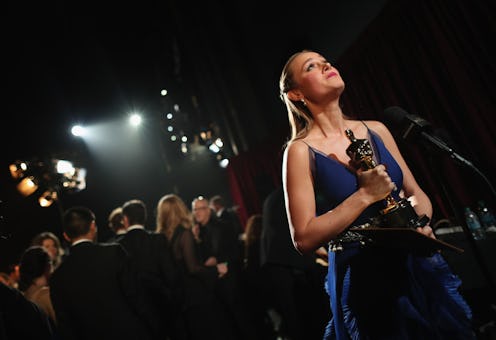
"Complicated." That's the best word to describe the kinds of roles that help win leading women little gold men. The Academy Award winners for Best Actress may play different kinds of characters — most often Best Actresses play a wife, mother, sister, daughter, or girlfriend, according to Huffington Post in 2015 — but it's safe to say they all have won for playing complicated women. When it comes to the movies they win for, though, is there something that ties them all together? Before the 89th Academy Awards announces the winner for Best Actress on Feb. 26, it's worth taking a look at every movie that led to a Best Actress win to see what they have in common.
From the Oscar's first Best Actress winner Janet Gaynor in 1927 and 1928 (the first Academy Awards honored both years) to Brie Larson who won in 2016, there are similarities in the kinds of films that land actresses the coveted prize. No surprise, it has a little something to do with gender — but not necessarily in a good way.
Looking back, only five of the 88 women to take home the Best Actress statues appeared in a film directed by a woman — that's approximately 5.7 percent. The stars who won for a female-directed film were Marlee Matlin for Randa Haines' Children Of A Lesser God in 1987; Holly Hunter for Jane Campion's The Piano in 1994; Hilary Swank for Kimberly Peirce's Boys Don't Cry in 2000; Charlize Theron for Patty Jenkins' Monster in 2004; and Meryl Streep for Phyllida Lloyd's The Iron Lady in 2012.
This unfortunate connection is not all that surprising, being that female-directed films have never been well represented at the Oscars. When it comes to the films nominated for Best Picture, only 12 have been directed by women. The earliest was 1986's Children of a Lesser God, helmed by the previously mentioned Haines. Most recently, Ava DuVernay's Selma was nominated at the 2015 ceremony. However, neither of these women were nominated for Best Director.
This is a common trend when you look at the list of female-directed movies that have been nominated for Best Picture. The three exceptions have been Sofia Coppola's Lost In Translation, Jane Campion's The Piano, and Kathryn Bigelow's The Hurt Locker. Bigelow is the only woman to be nominated twice for Best Picture — 2009's The Hurt Locker and again for 2012's Zero Dark Thirty — but she only earned one Best Director nomination.
In the Academy Awards' 88 years, only one female-directed movie — yes, one — has actually gone on to win Best Picture: Bigelow's The Hurt Locker. She's also the only woman to have ever taken home the Best Director prize.
Why does this all matter when it comes to the Best Actress category? Well, because even in an all-female category, the Oscars still manage to have a woman problem. This problem, though, is one that rarely gets talked about, perhaps because people don't see it as a real problem. Five women every year get nominated for Best Actress, isn't that enough female representation?
In actuality, the lack of female-directed movies in the Best Actress category is tied to a much bigger problem: In Hollywood, women are rarely celebrated for telling female stories. At the Academy Awards, this seems to be the case across the ballot. Prior to the 2016 ceremony, Newsweek looked back to see how many of the Best Picture winners were about women. The magazine found that out of 87 films that had won the coveted prize, only 14 were "female films," meaning they starred women and focused on their stories. Not one of those films was directed by a woman, but six of those films did lead to Best Actress wins.
What I learned here is that even when women are winning at the Oscars, they're still really not. Female films on every level are just not be taken as seriously by the Academy as those made and starring men. Even female roles are apparently worth more when they're made by men. They're worth gold.